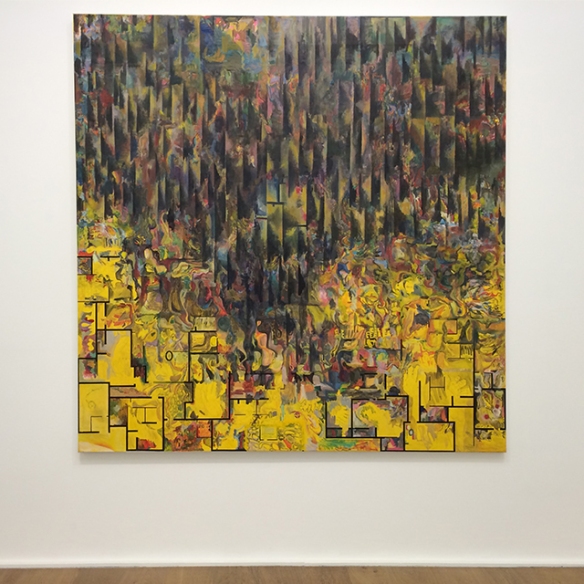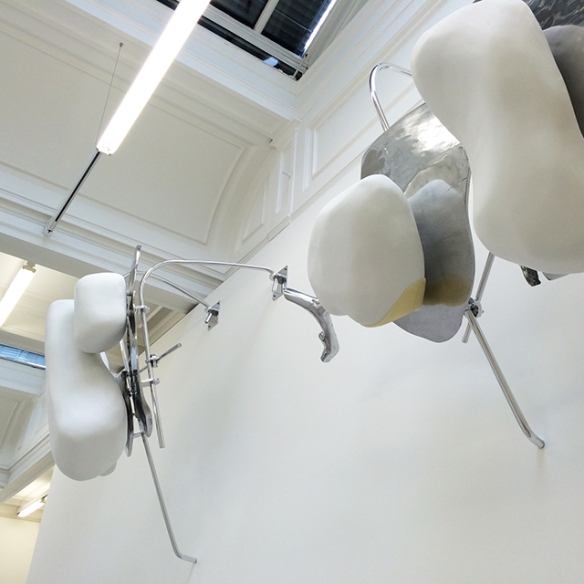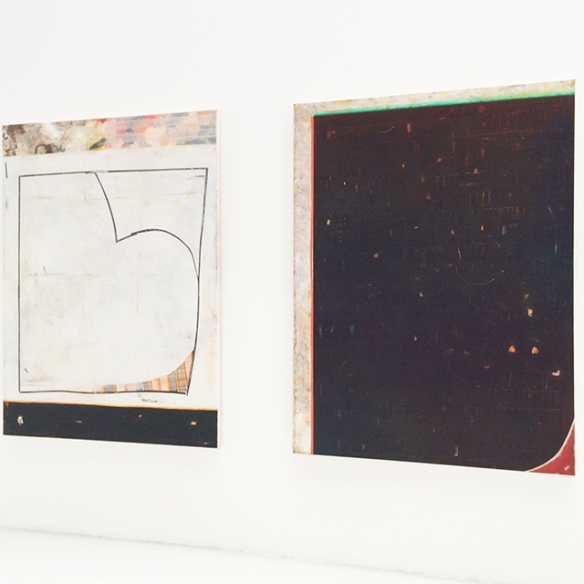As usual this run is a loop, but unlike the Regent’s Canal circuit described elsewhere, it extends further north to take in Parkland walk. Parkland Walk is a nature reserve created from an old railway used until 1970. Amongst its trees and wildlife, graffiti and nature have rounded off the sharp angular forms of station platforms and decorated the arched bridges that carry criss-crossing roads overhead. Meanwhile, walkers and cyclists barely notice the gentle gradient of this green corridor that rises slowly up to Highgate from Finsbury Park.
From here, the beautiful green space of Hampstead Heath provides the next section of the loop before I arrive at Camden Arts Centre which despite its name is well north of Camden on the Finchley Road. It is hosting Anya Gallaccio and as I wasn’t allowed to get a photo of another group-show inside, am relieved to see her artwork stretched out across the garden, where no photography restriction could possibly apply. As an object it looks like a long, woven, rope structure and even has some similarities to a hammock. This impression is reinforced further by it being draped across the trees in the garden, having extended from the roof terrace space above the garden cafe. With its clear structure of frayed, brown rope that has been joined with knots and cross-links, the real subject of the artwork seems to switch back towards the trees on which it is resting. Somehow the artwork serves as a reminder that the living material over which it is currently draped has an intricacy and strength all of its own.
Whilst Parkland Walk and Anya Gallaccio’s artwork have united to create a theme of nature and its regeneration into cultural artefacts, the next piece at Michael Werner Gallery remains obstinately removed from nature. Jorg Immendorf has painted two figures of children in a cartoon-like idiom that oppose nature through their puffed out cheeks and inflated torsos. They represent a sort of distorted or lost innocence. As the artwork was painted during the Vietnam war, the theme of lost innocence is also historically relevant, though the precise meaning of the image still remains hard to pin down. Formally, the painting is a cut-out round two figures and a pool of water they are sitting in.
Soap suds cascade down these yellow cartoonish torsos and collect on the surface of water, still buoyed by the vigour of a sponge that created them, and then a marvellous little piece of logic unites the yellow of the skin with the blue of the water to determine that the submerged body should necessarily be tinted green. This green and yellow colour palette sets up a system based on the false initial premise of the bright yellow human flesh and lends a sense of disquietude to the image but also a beauty. Then with false premises of my very own it is necessary to make all haste through the busy metropolis and visit the next stop which shall be the RA Schools show in Piccadilly.

Parkland Walk between Finsbury Park and Highgate. On the way to the Camden Arts Centre.

Guillermo Kuitca at Hauser and Wirth. The fragmentation cubism-lines become a floor plan.

Anya Gallaccio of Thomas Dane Gallery showing at Camden Arts Centre. Part of Making and Unmaking show.

Victoria Morton at Sadie Coles HQ. Colourful images with beautiful recurring motifs.

Jorg Immendorff at Michael Werner. The babies are iconic symbols of innocence amidst his fierce campaigning against the Vietnam war.

Nairy Baghramian at Marian Goodman Gallery. The pole structures hold the elements together

Anna Paterson at RA Schools Show 2016. Oil, pastel and print on aluminium. Another interesting artist at the RA schools show.

Joseph Grigely shows The Gregory Battcock Archive at Marian Goodman Gallery. Gregory himself is photographed in front of the first plane painted by Alexander Calder for Braniff Airlines in 1972.

Rafal Topolewski at RA Schools Show 2016. Yellow, Orange and Black and Turn. Great paintings.
